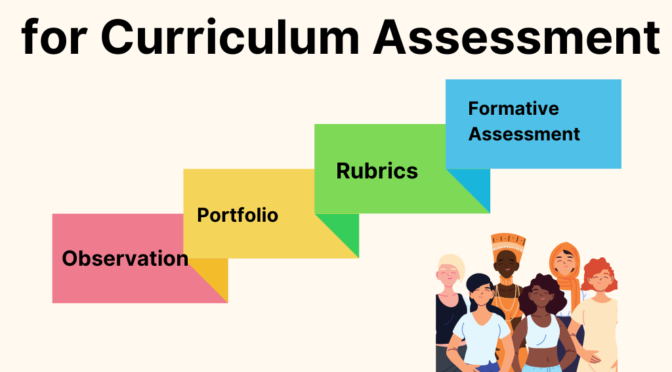Curriculum assessment at the elementary level involves evaluating the effectiveness of the curriculum in achieving its goals and objectives. Here are some tools and techniques used for curriculum assessment at the elementary level:
- Observation: Classroom observation is an important tool for assessing the effectiveness of the curriculum at the elementary level. Observing students in the classroom can provide valuable information about their behavior, engagement, and understanding of the material. It can also help teachers identify areas where students are struggling and adjust their instruction accordingly.
- Formative assessments: Formative assessments are used to evaluate student learning on a day-to-day basis. These assessments can take the form of quizzes, tests, essays, projects, or other assignments. They provide teachers with valuable information about student progress and can be used to adjust instruction and improve student outcomes.
- Portfolios: Portfolios are a collection of student work that demonstrate their progress over time. They can include a variety of assignments, projects, and assessments, and can be used to evaluate student learning in a holistic way.
- Rubrics: Rubrics are a tool used to evaluate student work based on a set of predetermined criteria. They can be used to assess a variety of assignments and projects, and provide students with clear expectations for their work.
- Standardized tests: Standardized tests are often used to assess student learning at the elementary level. These tests are designed to measure students’ knowledge and skills in specific subject areas and are often used to compare student performance across different schools or regions.
- Self-assessment and peer assessment: Self-assessment and peer assessment are important tools for developing metacognitive skills and promoting a growth mindset. Students can assess their own learning and set goals for improvement, while peer assessment can provide students with valuable feedback on their work.
- Parent-teacher conferences: Parent-teacher conferences provide an opportunity for parents to discuss their child’s progress with the teacher. These conferences can provide valuable feedback to teachers on the effectiveness of the curriculum, as well as suggestions for improvement.
Also Read : Learner Involvement in Curriculum Planning
By using a variety of tools and techniques for curriculum assessment at the elementary level, teachers can evaluate the effectiveness of their curriculum and make adjustments to improve student outcomes.
Also Visit : Prep with Harshita



벼룩시장 구인구직 및 신문 그대로 보기 (PC/모바일) | 구인구직 앱 어플 무료 설치 다운로드 | 모바일 벼룩시장 보는 방법 | 벼룩시장 부동산 | 지역별 벼룩시장 | 벼룩시장 종이신문 에 대해 알아보겠습니다. 섹스카지노사이트
https://www.youtube.com/@starissu
https://film35.tistory.com/2
https://www.youtube.com/channel/UCyxM_MlJsJQaQSuJ8lR58tg
https://kr.new-version.app/wp-content/uploads/2021/08/다음클리너.png
https://download.beer/app/naver-whale/
https://mintfin.tistory.com/entry/마인크래프트-apk-최신버전-무료-다운-링크-114-버전
https://www.youtube.com/@namoktv
https://www.youtube.com/@starissu
https://acase.co.kr/84
https://www.youtube.com/@namoktv
https://www.youtube.com/@namoktv
https://honeytiplabs.com/아이폰-천지인-키보드-설정-10키-사용-방법/
https://www.youtube.com/@namoktv
https://www.youtube.com/@starissu
https://www.youtube.com/channel/UCJLXoLNzHeK70WCJlQNYf-g
https://www.youtube.com/channel/UCJLXoLNzHeK70WCJlQNYf-g
https://itgunza.com/3457
아름다운스웨디시업소
https://itgunza.com/3457
https://microsoft-powerpoint-2010.softonic.kr/download
https://www.youtube.com/channel/UCyt2dGrKTf9KpBk1jdUl3oA
https://edithvolo.com/page/15/
https://www.youtube.com/@소중한인연-c1u
https://www.youtube.com/@trot-workshop
강남안마시술소중계업체
https://itgunza.com/3457
https://microsoft-powerpoint-2010.softonic.kr/download
https://nicesongtoyou.com/라이프/장애등급-혜택-총정리-및-주요-내용-안내/
이태원게이바
https://itlearn.kr/파워포인트-무료설치-다운로드-방법/
https://www.youtube.com/@가요여행
https://www.youtube.com/@가요여행
https://www.youtube.com/channel/UCeVNIN2PoYFRDmFyYRmK7bQ
https://www.youtube.com/@가요여행
https://oculus-vr.co.kr/hwang-hee-chan-wolverhampton/
이태원스웨디시안마게이클럽
https://nicesongtoyou.com/today-fortune/horoscope-by-zodiac/
https://www.youtube.com/@GILMONG201
Aktive Sterbehilfe in Österreich https://mein.aufstehn.at/petitions/aktive-sterbehilfe
Alle Drogen legalisieren https://mein.aufstehn.at/petitions/alle-drogen-legalisieren
Aktive Sterbehilfe in Österreich https://mein.aufstehn.at/petitions/aktive-sterbehilfe
https://www.youtube.com/@GILMONG201
https://mintfin.tistory.com/tag/미스트롯220언택트20판정단20신청
https://www.youtube.com/channel/UCeVNIN2PoYFRDmFyYRmK7bQ
https://www.youtube.com/channel/UCeVNIN2PoYFRDmFyYRmK7bQ
https://edithvolo.com/이력서-양식/
https://edithvolo.com/콜택시-부르는법/
https://www.youtube.com/@TV신호등
https://new-software.download/windows/vlc-player/
https://www.youtube.com/channel/UCe0Qrv4HvRK_iup3X_cNdBA
https://www.youtube.com/channel/UCe0Qrv4HvRK_iup3X_cNdBA
https://www.youtube.com/channel/UCe0Qrv4HvRK_iup3X_cNdBA
https://www.youtube.com/@TV신호등
https://www.youtube.com/channel/UCe0Qrv4HvRK_iup3X_cNdBA
https://www.youtube.com/@trot-workshop
https://www.youngstarmedia.com/
영등포안마살롱
https://www.youtube.com/@소중한인연-c1u
벼룩시장 구인구직 및 신문 그대로 보기 (PC/모바일) | 구인구직 앱 어플 무료 설치 다운로드 | 모바일 벼룩시장 보는 방법 | 벼룩시장 부동산 | 지역별 벼룩시장 | 벼룩시장 종이신문 에 대해 알아보겠습니다. 섹스카지노사이트
https://www.youtube.com/@소중한인연-c1u
https://www.youtube.com/channel/UCyt2dGrKTf9KpBk1jdUl3oA
https://www.youtube.com/channel/UCeVNIN2PoYFRDmFyYRmK7bQ
https://www.youtube.com/@가요여행
https://www.youtube.com/@가요여행
https://www.youtube.com/channel/UCyt2dGrKTf9KpBk1jdUl3oA
https://www.youtube.com/@가요여행
https://www.youtube.com/channel/UCyt2dGrKTf9KpBk1jdUl3oA
https://www.youtube.com/channel/UCeVNIN2PoYFRDmFyYRmK7bQ
https://www.youtube.com/channel/UCeVNIN2PoYFRDmFyYRmK7bQ
https://www.youtube.com/channel/UCyt2dGrKTf9KpBk1jdUl3oA
https://www.youtube.com/@가요여행
https://www.youtube.com/@소중한인연-c1u
https://www.youtube.com/@소중한인연-c1u
https://www.youtube.com/channel/UCe0Qrv4HvRK_iup3X_cNdBA
https://www.youngstarmedia.com/
https://www.youtube.com/@영스타미디어
https://www.youtube.com/channel/UCJLXoLNzHeK70WCJlQNYf-g
https://www.youtube.com/channel/UCJLXoLNzHeK70WCJlQNYf-g
https://kleonet.com/entry/tag/트롯걸즈재팬-1st-미니-콘서트-the-beginning/
https://www.youtube.com/@BIMONG
https://nicesongtoyou.com/
https://www.youtube.com/@BIMONG
https://nicesongtoyou.com/loan/small-loans/
https://www.youtube.com/@DaftTaengk
https://www.youtube.com/channel/UCyxM_MlJsJQaQSuJ8lR58tg
https://www.youtube.com/channel/UCyxM_MlJsJQaQSuJ8lR58tg
https://www.youtube.com/channel/UCyxM_MlJsJQaQSuJ8lR58tg